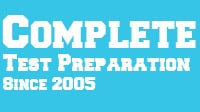
Scientific Reasoning Practice Questions
- Posted by Brian Stocker
- Date October 25, 2017
- Comments 2 comments
Reason!
Scientific Reasoning, as the name implies, doesn’t test your knowledge, but rather tests your ability to reason, as well as your ability to analyze and understand data. The questions provide you with everything you need to know – you have to reason your way through like a scientist using the scientific method.
Practice Questions
Proteins
Proteins are large molecules consisting of many amino acids joined together. They form the basis of many different body tissues and play an essential role in a variety of biological processes such as catalyzing chemical reactions, transporting molecules such as oxygen, our immune system and transmitting messages between cells. Some proteins have a structural role, for instance, movements of the proteins actin and myosin are responsible for the contraction of skeletal muscle. A property of many proteins is that they specifically bind to a certain molecule or class of molecules. Antibodies are an example of globular proteins that attach to one particular type of molecule. In fact, the enzyme-linked immunosorbent assay (ELISA), uses antibodies to detect various biomolecules in the blood, making it one of the most sensitive tests in modern medicine. Enzymes, however are probably the most important group of proteins. Virtually every reaction in a living cell requires an enzyme to lower the activation energy of the reaction.
1. Which of the following is not an example of a protein?
a. Actin
b. Myosin
c. Amino acid
d. Antibodies
2. Enzymes are known to catalyze reactions in the body. What does this mean?
a. They create a chemical reaction
b. They speed up chemical reactions
c. They are involved in chemical reactions
d. Provide energy for the reaction to occur
3. Which of the following is not a feature of enzymes?
a. They lower the energy needed to begin a reaction
b. They are specific
c. They are proteins
d. They are antibodies
4. Which of the following is another example of a structural protein that can be found in the human body?
a. Haemoglobin
b. Keratin
c. Insulin
d. Estrogen
The Effect of Insulin on Glucose Uptake and Metabolism
The hormone insulin is another example of a protein. It plays a number of roles in the body’s metabolism helping it to control blood glucose levels. Insulin signals the liver, muscle and fat cells to remove glucose from the blood, helping cells to take up glucose to use as energy. If the body has sufficient energy, insulin signals the liver to take up glucose and store it as glycogen.
To regulate glucose, insulin binds to its receptor (1), which in turn starts many protein activation cascades (2). These include translocation of the Glut-4 transporter to the plasma membrane and influx of glucose (3), glycogen synthesis (4), glycolysis (5) and fatty acid synthesis (6).
5. The process above shows how glucose is controlled in a healthy individual. What would be the outcome if this process failed to operate correctly?
a. Heart Disease
b. Cancer
c. Diabetes
d. Pancreatitis
6. Name the organ responsible for making the hormone insulin.
a. Small intestine
b. Gall Bladder
c. Liver
d. Pancreas
7. Insulin is another example of a protein. Which of the following statements best describes the role of insulin in the body?
a. Insulin regulates how the body stores and uses glucose and fat.
b. Insulin turns glucose into glycogen
c. Insulin triggers the formation of fatty acids
d. Insulin allows glucose transporter-4 to move glucose through the plasma membrane
8. Name the cellular process that all cells require glucose as a reactant for:
a. Photosynthesis
b. Cell division
c. Respiration
d. Reproduction
9. Which of the following conclusions are correct, relating to insulin’s effect on glucose uptake:
a. When blood glucose levels are low, insulin causes the liver as well as muscle and fat cells to remove glucose from the blood.
b. Insulin prevents glucose from moving through the glucose transporter molecule when glucose levels are high
c. The more glucose is in the blood; the more insulin is released to control it
d. Insulin triggers the muscle cells to take up excess glucose and store it as glycogen.
Population Dynamics
Beneficial Mutations
In many cases mutations that cause changes in protein sequences can be harmful to an organism. However, on occasion, in a given environment, some mutations can have a positive effect, for example, it may allow a mutant organism to withstand particular environmental stresses better than wild-type organisms, or reproduce more quickly. In these cases, a mutation will tend to become more common in a population through natural selection.
In an experiment, random mutations were introduced into a vesicular stomatitis virus by site-directed mutagenesis, and the fitness of each mutant was compared with the ancestral type, the processed results can be seen below. A fitness of zero, less than one, one, more than one, respectively, indicates that mutations are lethal, deleterious, neutral, and advantageous.
10. Which level of fitness is most frequent in the virus after introduction?
a. Lethal
b. Deleterious
c. Neutral
d. Advantageous
11. What is the total frequency of individuals with deleterious fitness?
a. 2.8
b. 0.33
c. 0.4
d. 5
12. Comment on the frequency of the mutation in the population, if it was left for several generations.
a. The mutation will become more common in the population
b. The mutation will become less common in the population
c. The mutation will remain static in the population
d. This mutation will cause the population to become extinct
13. Which of the following statements is true regarding this example of natural selection:
a. Natural selection determines which trait (mutant or ancestral) will survive.
b. Natural selection acts on the genotype of the virus
c. Natural selection will determine the environment the virus is in.
d. None of these
Answer Key
1. C
Choices A and B are incorrect as the text tells us they are structural proteins. 1 C Choices A and B are incorrect as the text tells us they are structural proteins. Choice C is correct as amino acids are the sub-units which join together to make a protein.Choice D is also incorrect as the text tells us that they are globular proteins.
2. B
Choices A and D are incorrect – enzymes reduce the amount of energy needed, they do not create the reaction or provide the energy. Choice B is correct – the definition of a catalyst “speeding up a chemical reaction by lowering the amount of energy needed.”Choice C is incorrect – enzymes are not involved in reactions, they are not a reactant nor become a product, which is why they can be reused again once a reaction has finished.
3. D
Enzymes lower the energy needed to begin the reaction, they are specific, meaning that each enzyme only catalyzes one reaction. The text also tells us that they are proteins; therefore choices A, B and C are incorrect. Enzymes are not antibodies. Therefore choice D is the correct choice.
4. B
Choice A – hemoglobin is a globular protein, carrying oxygen in red blood cells and is incorrect. Choice B is correct as keratin is a protein found in skin and nails, a building material for the body. Choice C is incorrect – insulin controls blood glucose levels. Choice D is incorrect – estrogen is the female reproductive hormone.
5. C
An inability to make or produce sufficient levels of insulin results in diabetes.
6. D
Choice A is incorrect; this is where food is digested before it enters the bloodstream. Choice B is incorrect, this where bile is stored C is incorrect; the liver does store excess glucose taken out of the blood as glycogen.D is correct; the pancreas is responsible for producing insulin
7. A
A is correct; insulin helps control bloo>d glucose levels by signaling the liver and muscle and fat cells to absorb glucose from the blood. If the body has enough energy, insulin signals the liver to take up glucose and store it as glycogen. Choice B is incorrect; insulin does not turn glucose into glycogen; this is the product that the liver turns glucose into for storage. Choice C is incorrect as it only gives a partial answer. Choice D is incorrect as this is a partial answer.
8. C
Choice A is incorrect as glucose is a product of photosynthesis and only occurs in plants. Choice B is incorrect as glucose is not used directly in cell division C is correct as glucose is one of the essential reactants needed to for respiration. D is incorrect as- glucose is not a primary reactant needed for reproduction.
9. C
Choice A is incorrect as this occurs when blood> glucose levels are high. Choice B is incorrect as insulin will allow glucose to cross the plasma membrane removing excess glucose from the bloodstream. Choice C is the correct answer; the concentration of glucose directly correlates to the amount of insulin needed. Choice D is incorrect as this process occurs in the liver.
10. A
Choice A is correct – the greatest frequency in the population is a fitness of 0, which is considered lethal.
11. B
(0.3 x0.02) + (0.4 x 0.02) + (0.6 x 0.05) + (0.7 x 0.05) + (0.8 x 0.05) + (0.9 x 0.15)= 0.325 (0.33 rounded)
12. B
For a mutation to become widespread in a population it needs to be inherited by the offspring, alleles that are lethal or deleterious are not passed on in most cases, as the carrier often does not reach reproductive maturity. Therefore we can expect the mutation to become less common, making choice B is correct.
13. A
Choice A is correct, as the interactions between individuals and their environment (i.e., the trait) are what determines whether their genetic information will be passed on or not. In this case, the individuals who are wild type would have a higher level of fitness and therefore be more likely to reproduce (or in the case of viruses, replicate) and pass on their non-mutant genotype.
Date Published: Wednesday, October 25th, 2017
Date Modified: Monday, June 19th, 2023
Got a Question? Email me anytime - Brian@test-preparation.ca
You may also like
Top Interview Questions
Top Interview Question – Tell me about yourself This is an opportunity to introduce yourself and give a quick summary of your background and qualifications. Highlight relevant experiences and skills that qualify you for the job. Example response My name …
Spelling Rules
Improving and learning spelling takes time, practice and learning the rules. Understanding the spelling rules and exceptions to the rules is the greatest strategy to help you know how to spell. Understanding spelling rules is just one of the numerous …
Logic and Reasoning Practice and Tutorial
Logic tests are all about your ability to reason clearly, not about what you can memorize and recall. Some High School Exams, have logic problems which are a type of syllogism. Another type of logic related question is Arithmetic logic, which …

2 Comments
Need study guide for placement test for shaw high school
Excellent post. Very helpful info particularly the closing part :